Think Sociology Assignment 2022
VerifiedAdded on 2022/10/07
|8
|1818
|22
Assignment
AI Summary
Contribute Materials
Your contribution can guide someone’s learning journey. Share your
documents today.
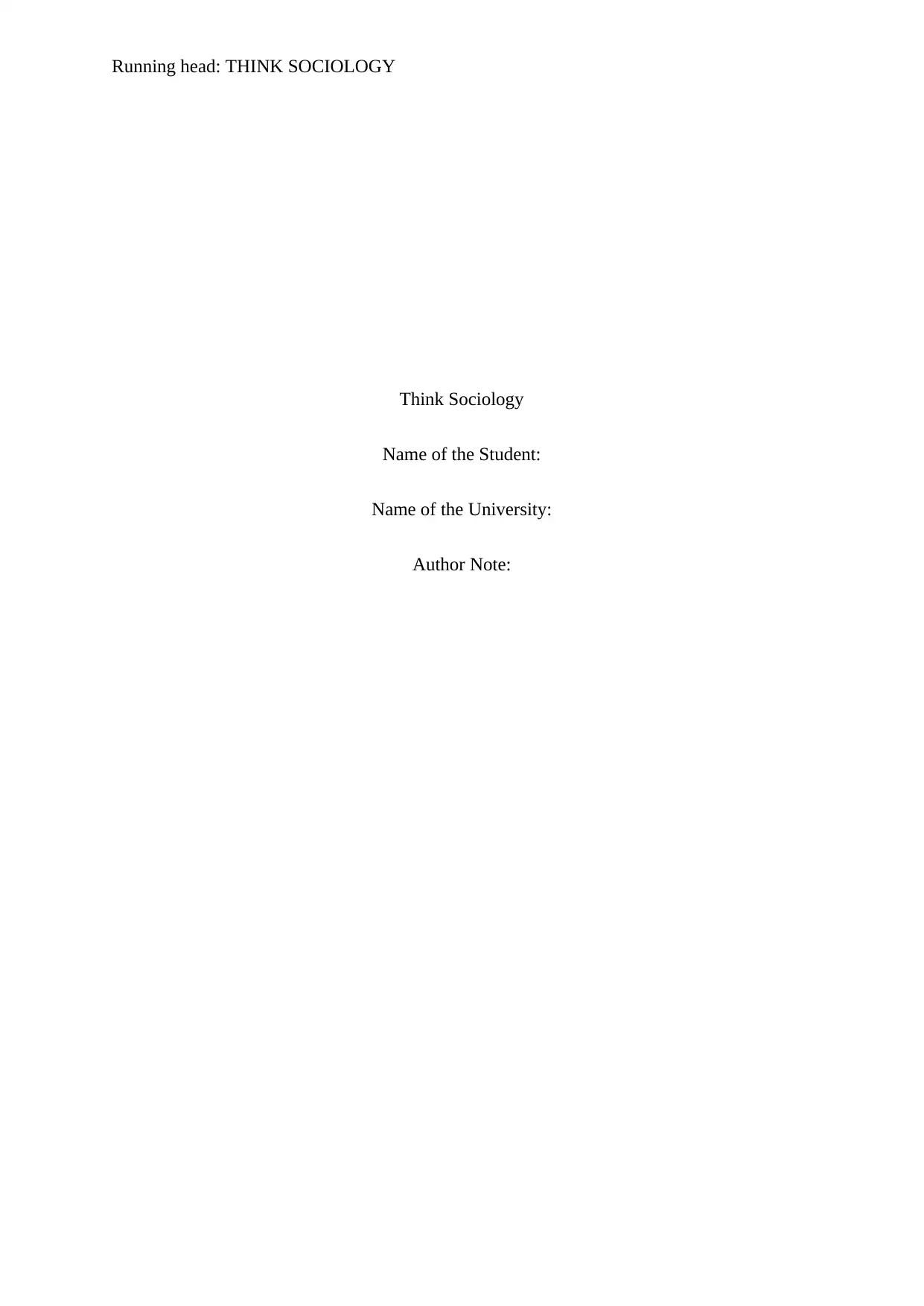
Running head: THINK SOCIOLOGY
Think Sociology
Name of the Student:
Name of the University:
Author Note:
Think Sociology
Name of the Student:
Name of the University:
Author Note:
Secure Best Marks with AI Grader
Need help grading? Try our AI Grader for instant feedback on your assignments.
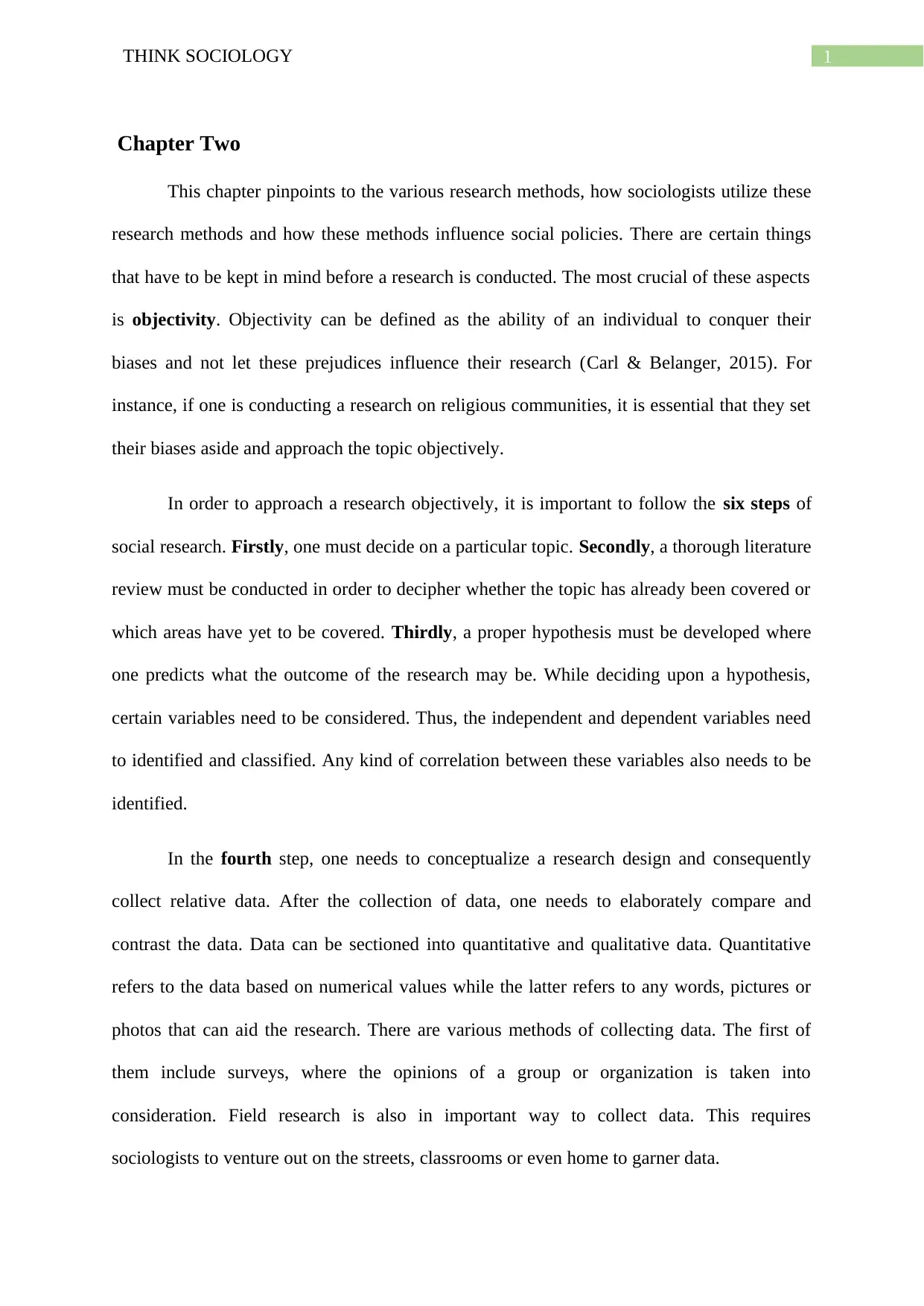
1THINK SOCIOLOGY
Chapter Two
This chapter pinpoints to the various research methods, how sociologists utilize these
research methods and how these methods influence social policies. There are certain things
that have to be kept in mind before a research is conducted. The most crucial of these aspects
is objectivity. Objectivity can be defined as the ability of an individual to conquer their
biases and not let these prejudices influence their research (Carl & Belanger, 2015). For
instance, if one is conducting a research on religious communities, it is essential that they set
their biases aside and approach the topic objectively.
In order to approach a research objectively, it is important to follow the six steps of
social research. Firstly, one must decide on a particular topic. Secondly, a thorough literature
review must be conducted in order to decipher whether the topic has already been covered or
which areas have yet to be covered. Thirdly, a proper hypothesis must be developed where
one predicts what the outcome of the research may be. While deciding upon a hypothesis,
certain variables need to be considered. Thus, the independent and dependent variables need
to identified and classified. Any kind of correlation between these variables also needs to be
identified.
In the fourth step, one needs to conceptualize a research design and consequently
collect relative data. After the collection of data, one needs to elaborately compare and
contrast the data. Data can be sectioned into quantitative and qualitative data. Quantitative
refers to the data based on numerical values while the latter refers to any words, pictures or
photos that can aid the research. There are various methods of collecting data. The first of
them include surveys, where the opinions of a group or organization is taken into
consideration. Field research is also in important way to collect data. This requires
sociologists to venture out on the streets, classrooms or even home to garner data.
Chapter Two
This chapter pinpoints to the various research methods, how sociologists utilize these
research methods and how these methods influence social policies. There are certain things
that have to be kept in mind before a research is conducted. The most crucial of these aspects
is objectivity. Objectivity can be defined as the ability of an individual to conquer their
biases and not let these prejudices influence their research (Carl & Belanger, 2015). For
instance, if one is conducting a research on religious communities, it is essential that they set
their biases aside and approach the topic objectively.
In order to approach a research objectively, it is important to follow the six steps of
social research. Firstly, one must decide on a particular topic. Secondly, a thorough literature
review must be conducted in order to decipher whether the topic has already been covered or
which areas have yet to be covered. Thirdly, a proper hypothesis must be developed where
one predicts what the outcome of the research may be. While deciding upon a hypothesis,
certain variables need to be considered. Thus, the independent and dependent variables need
to identified and classified. Any kind of correlation between these variables also needs to be
identified.
In the fourth step, one needs to conceptualize a research design and consequently
collect relative data. After the collection of data, one needs to elaborately compare and
contrast the data. Data can be sectioned into quantitative and qualitative data. Quantitative
refers to the data based on numerical values while the latter refers to any words, pictures or
photos that can aid the research. There are various methods of collecting data. The first of
them include surveys, where the opinions of a group or organization is taken into
consideration. Field research is also in important way to collect data. This requires
sociologists to venture out on the streets, classrooms or even home to garner data.
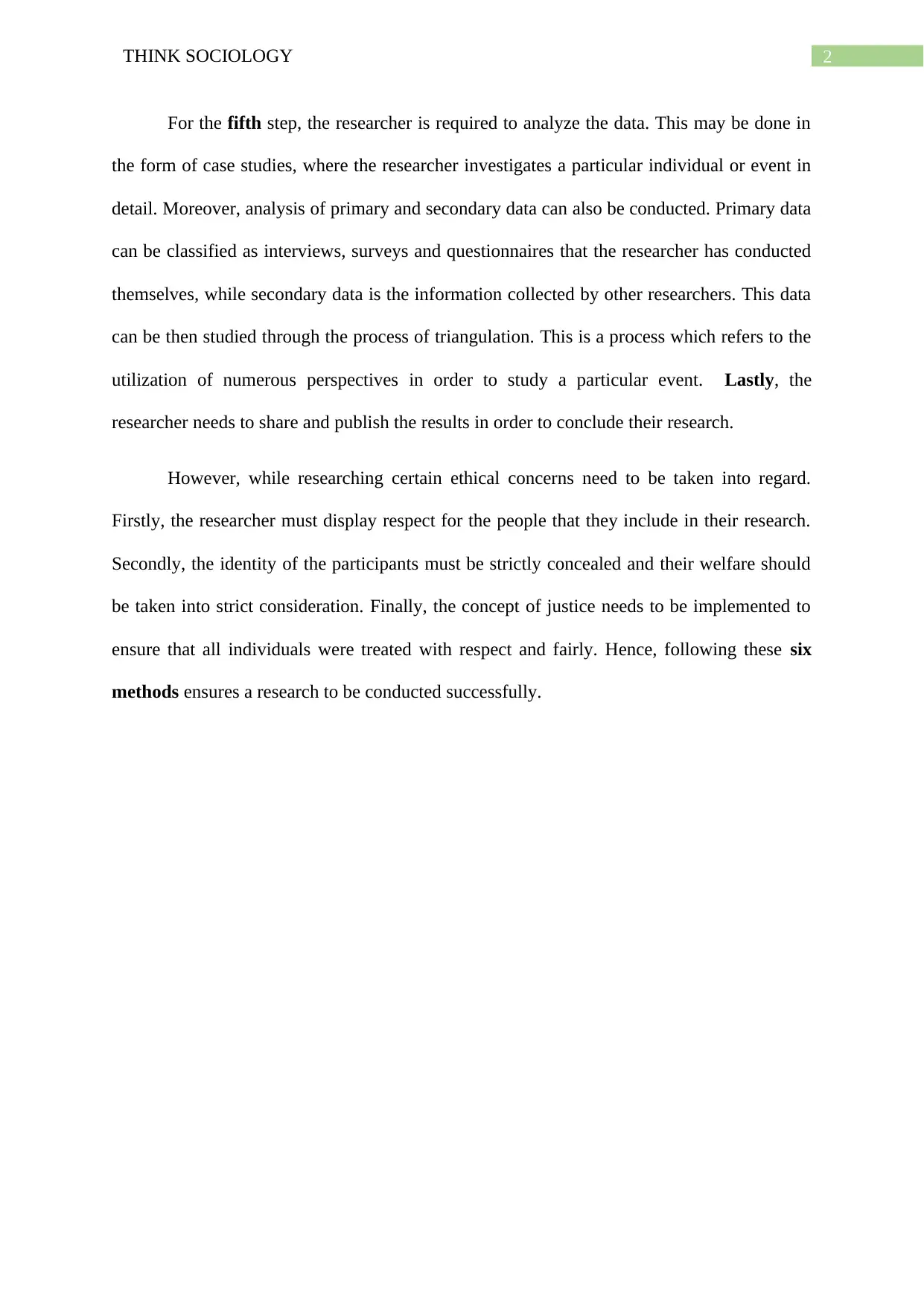
2THINK SOCIOLOGY
For the fifth step, the researcher is required to analyze the data. This may be done in
the form of case studies, where the researcher investigates a particular individual or event in
detail. Moreover, analysis of primary and secondary data can also be conducted. Primary data
can be classified as interviews, surveys and questionnaires that the researcher has conducted
themselves, while secondary data is the information collected by other researchers. This data
can be then studied through the process of triangulation. This is a process which refers to the
utilization of numerous perspectives in order to study a particular event. Lastly, the
researcher needs to share and publish the results in order to conclude their research.
However, while researching certain ethical concerns need to be taken into regard.
Firstly, the researcher must display respect for the people that they include in their research.
Secondly, the identity of the participants must be strictly concealed and their welfare should
be taken into strict consideration. Finally, the concept of justice needs to be implemented to
ensure that all individuals were treated with respect and fairly. Hence, following these six
methods ensures a research to be conducted successfully.
For the fifth step, the researcher is required to analyze the data. This may be done in
the form of case studies, where the researcher investigates a particular individual or event in
detail. Moreover, analysis of primary and secondary data can also be conducted. Primary data
can be classified as interviews, surveys and questionnaires that the researcher has conducted
themselves, while secondary data is the information collected by other researchers. This data
can be then studied through the process of triangulation. This is a process which refers to the
utilization of numerous perspectives in order to study a particular event. Lastly, the
researcher needs to share and publish the results in order to conclude their research.
However, while researching certain ethical concerns need to be taken into regard.
Firstly, the researcher must display respect for the people that they include in their research.
Secondly, the identity of the participants must be strictly concealed and their welfare should
be taken into strict consideration. Finally, the concept of justice needs to be implemented to
ensure that all individuals were treated with respect and fairly. Hence, following these six
methods ensures a research to be conducted successfully.
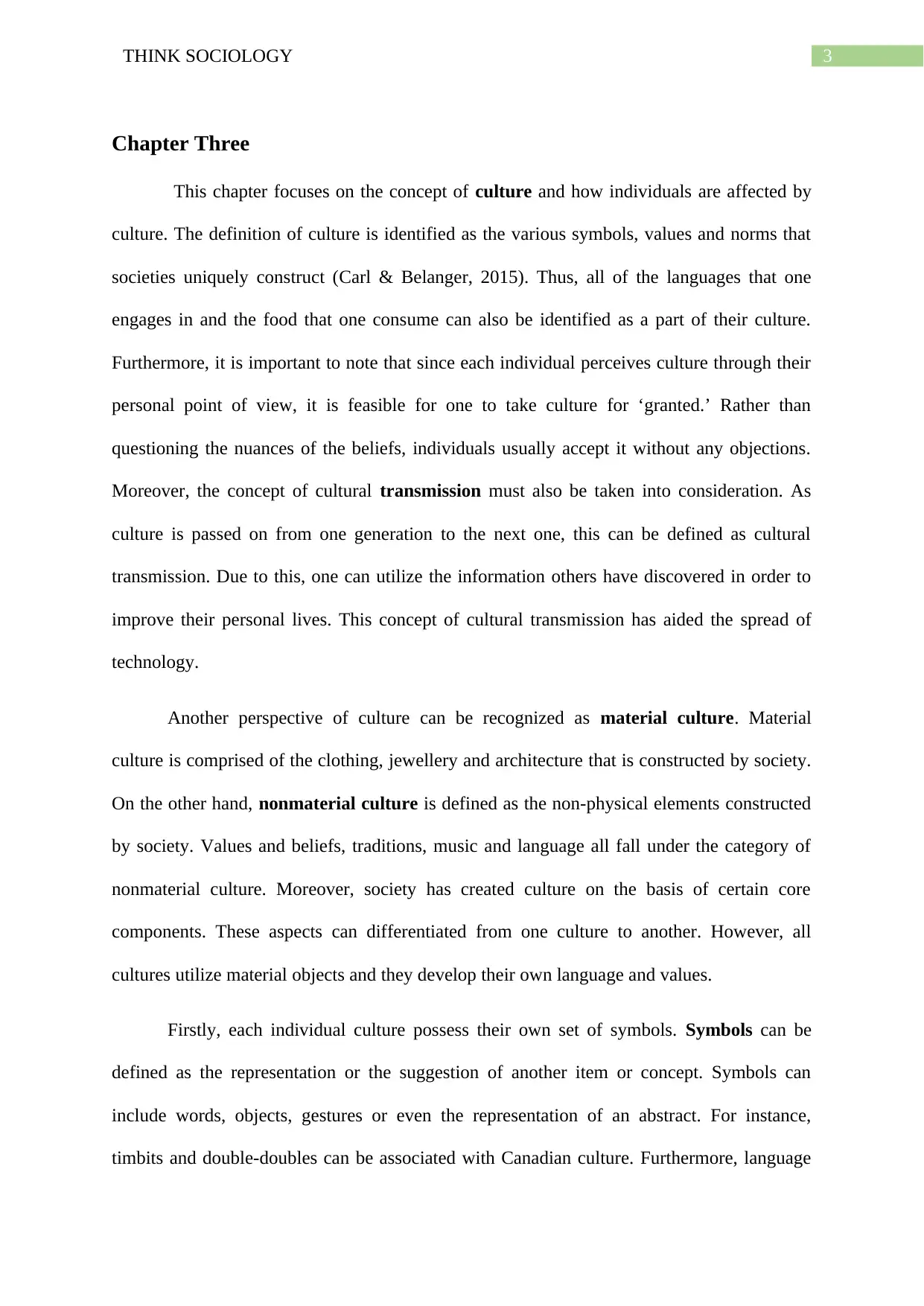
3THINK SOCIOLOGY
Chapter Three
This chapter focuses on the concept of culture and how individuals are affected by
culture. The definition of culture is identified as the various symbols, values and norms that
societies uniquely construct (Carl & Belanger, 2015). Thus, all of the languages that one
engages in and the food that one consume can also be identified as a part of their culture.
Furthermore, it is important to note that since each individual perceives culture through their
personal point of view, it is feasible for one to take culture for ‘granted.’ Rather than
questioning the nuances of the beliefs, individuals usually accept it without any objections.
Moreover, the concept of cultural transmission must also be taken into consideration. As
culture is passed on from one generation to the next one, this can be defined as cultural
transmission. Due to this, one can utilize the information others have discovered in order to
improve their personal lives. This concept of cultural transmission has aided the spread of
technology.
Another perspective of culture can be recognized as material culture. Material
culture is comprised of the clothing, jewellery and architecture that is constructed by society.
On the other hand, nonmaterial culture is defined as the non-physical elements constructed
by society. Values and beliefs, traditions, music and language all fall under the category of
nonmaterial culture. Moreover, society has created culture on the basis of certain core
components. These aspects can differentiated from one culture to another. However, all
cultures utilize material objects and they develop their own language and values.
Firstly, each individual culture possess their own set of symbols. Symbols can be
defined as the representation or the suggestion of another item or concept. Symbols can
include words, objects, gestures or even the representation of an abstract. For instance,
timbits and double-doubles can be associated with Canadian culture. Furthermore, language
Chapter Three
This chapter focuses on the concept of culture and how individuals are affected by
culture. The definition of culture is identified as the various symbols, values and norms that
societies uniquely construct (Carl & Belanger, 2015). Thus, all of the languages that one
engages in and the food that one consume can also be identified as a part of their culture.
Furthermore, it is important to note that since each individual perceives culture through their
personal point of view, it is feasible for one to take culture for ‘granted.’ Rather than
questioning the nuances of the beliefs, individuals usually accept it without any objections.
Moreover, the concept of cultural transmission must also be taken into consideration. As
culture is passed on from one generation to the next one, this can be defined as cultural
transmission. Due to this, one can utilize the information others have discovered in order to
improve their personal lives. This concept of cultural transmission has aided the spread of
technology.
Another perspective of culture can be recognized as material culture. Material
culture is comprised of the clothing, jewellery and architecture that is constructed by society.
On the other hand, nonmaterial culture is defined as the non-physical elements constructed
by society. Values and beliefs, traditions, music and language all fall under the category of
nonmaterial culture. Moreover, society has created culture on the basis of certain core
components. These aspects can differentiated from one culture to another. However, all
cultures utilize material objects and they develop their own language and values.
Firstly, each individual culture possess their own set of symbols. Symbols can be
defined as the representation or the suggestion of another item or concept. Symbols can
include words, objects, gestures or even the representation of an abstract. For instance,
timbits and double-doubles can be associated with Canadian culture. Furthermore, language
Secure Best Marks with AI Grader
Need help grading? Try our AI Grader for instant feedback on your assignments.
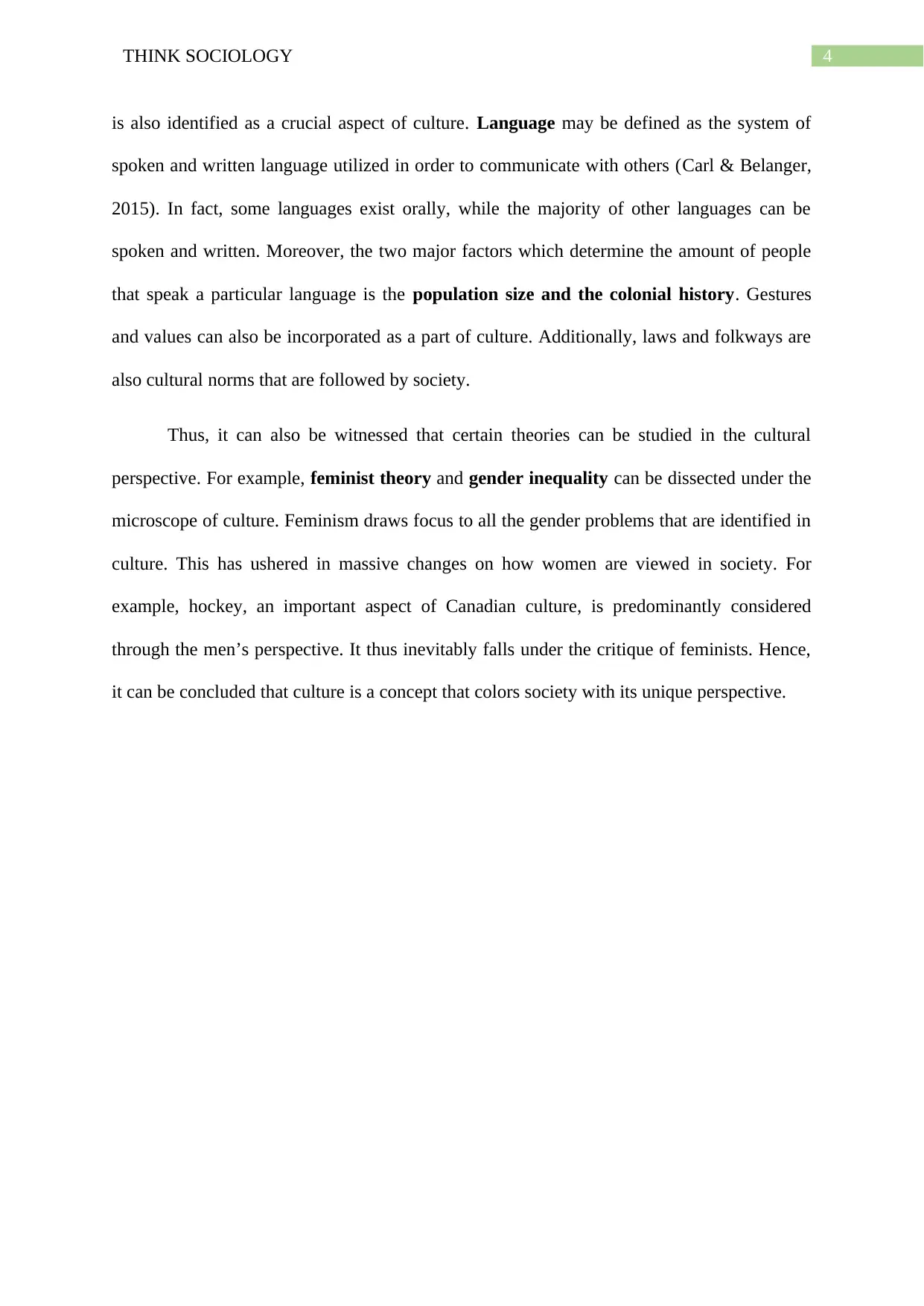
4THINK SOCIOLOGY
is also identified as a crucial aspect of culture. Language may be defined as the system of
spoken and written language utilized in order to communicate with others (Carl & Belanger,
2015). In fact, some languages exist orally, while the majority of other languages can be
spoken and written. Moreover, the two major factors which determine the amount of people
that speak a particular language is the population size and the colonial history. Gestures
and values can also be incorporated as a part of culture. Additionally, laws and folkways are
also cultural norms that are followed by society.
Thus, it can also be witnessed that certain theories can be studied in the cultural
perspective. For example, feminist theory and gender inequality can be dissected under the
microscope of culture. Feminism draws focus to all the gender problems that are identified in
culture. This has ushered in massive changes on how women are viewed in society. For
example, hockey, an important aspect of Canadian culture, is predominantly considered
through the men’s perspective. It thus inevitably falls under the critique of feminists. Hence,
it can be concluded that culture is a concept that colors society with its unique perspective.
is also identified as a crucial aspect of culture. Language may be defined as the system of
spoken and written language utilized in order to communicate with others (Carl & Belanger,
2015). In fact, some languages exist orally, while the majority of other languages can be
spoken and written. Moreover, the two major factors which determine the amount of people
that speak a particular language is the population size and the colonial history. Gestures
and values can also be incorporated as a part of culture. Additionally, laws and folkways are
also cultural norms that are followed by society.
Thus, it can also be witnessed that certain theories can be studied in the cultural
perspective. For example, feminist theory and gender inequality can be dissected under the
microscope of culture. Feminism draws focus to all the gender problems that are identified in
culture. This has ushered in massive changes on how women are viewed in society. For
example, hockey, an important aspect of Canadian culture, is predominantly considered
through the men’s perspective. It thus inevitably falls under the critique of feminists. Hence,
it can be concluded that culture is a concept that colors society with its unique perspective.
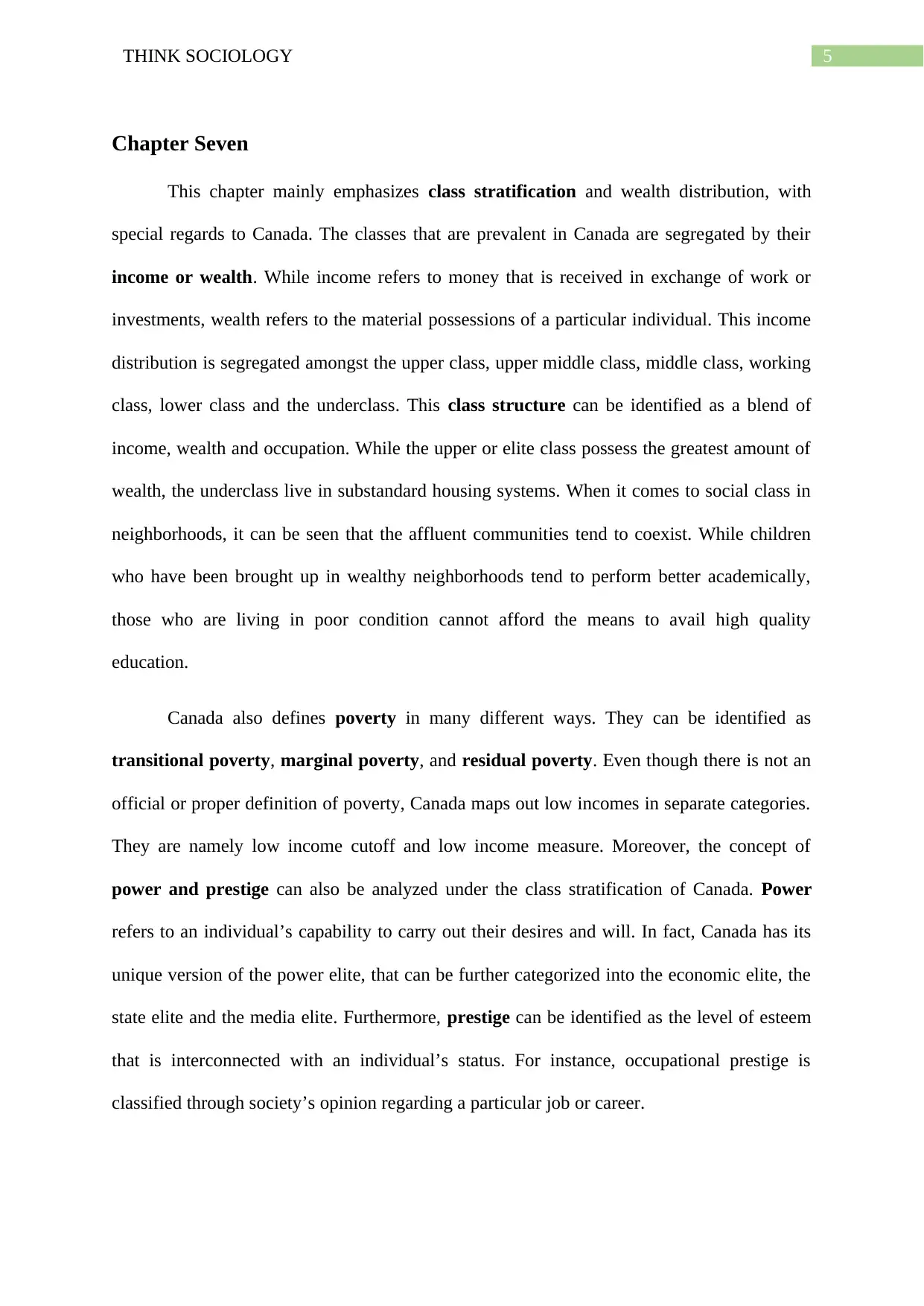
5THINK SOCIOLOGY
Chapter Seven
This chapter mainly emphasizes class stratification and wealth distribution, with
special regards to Canada. The classes that are prevalent in Canada are segregated by their
income or wealth. While income refers to money that is received in exchange of work or
investments, wealth refers to the material possessions of a particular individual. This income
distribution is segregated amongst the upper class, upper middle class, middle class, working
class, lower class and the underclass. This class structure can be identified as a blend of
income, wealth and occupation. While the upper or elite class possess the greatest amount of
wealth, the underclass live in substandard housing systems. When it comes to social class in
neighborhoods, it can be seen that the affluent communities tend to coexist. While children
who have been brought up in wealthy neighborhoods tend to perform better academically,
those who are living in poor condition cannot afford the means to avail high quality
education.
Canada also defines poverty in many different ways. They can be identified as
transitional poverty, marginal poverty, and residual poverty. Even though there is not an
official or proper definition of poverty, Canada maps out low incomes in separate categories.
They are namely low income cutoff and low income measure. Moreover, the concept of
power and prestige can also be analyzed under the class stratification of Canada. Power
refers to an individual’s capability to carry out their desires and will. In fact, Canada has its
unique version of the power elite, that can be further categorized into the economic elite, the
state elite and the media elite. Furthermore, prestige can be identified as the level of esteem
that is interconnected with an individual’s status. For instance, occupational prestige is
classified through society’s opinion regarding a particular job or career.
Chapter Seven
This chapter mainly emphasizes class stratification and wealth distribution, with
special regards to Canada. The classes that are prevalent in Canada are segregated by their
income or wealth. While income refers to money that is received in exchange of work or
investments, wealth refers to the material possessions of a particular individual. This income
distribution is segregated amongst the upper class, upper middle class, middle class, working
class, lower class and the underclass. This class structure can be identified as a blend of
income, wealth and occupation. While the upper or elite class possess the greatest amount of
wealth, the underclass live in substandard housing systems. When it comes to social class in
neighborhoods, it can be seen that the affluent communities tend to coexist. While children
who have been brought up in wealthy neighborhoods tend to perform better academically,
those who are living in poor condition cannot afford the means to avail high quality
education.
Canada also defines poverty in many different ways. They can be identified as
transitional poverty, marginal poverty, and residual poverty. Even though there is not an
official or proper definition of poverty, Canada maps out low incomes in separate categories.
They are namely low income cutoff and low income measure. Moreover, the concept of
power and prestige can also be analyzed under the class stratification of Canada. Power
refers to an individual’s capability to carry out their desires and will. In fact, Canada has its
unique version of the power elite, that can be further categorized into the economic elite, the
state elite and the media elite. Furthermore, prestige can be identified as the level of esteem
that is interconnected with an individual’s status. For instance, occupational prestige is
classified through society’s opinion regarding a particular job or career.
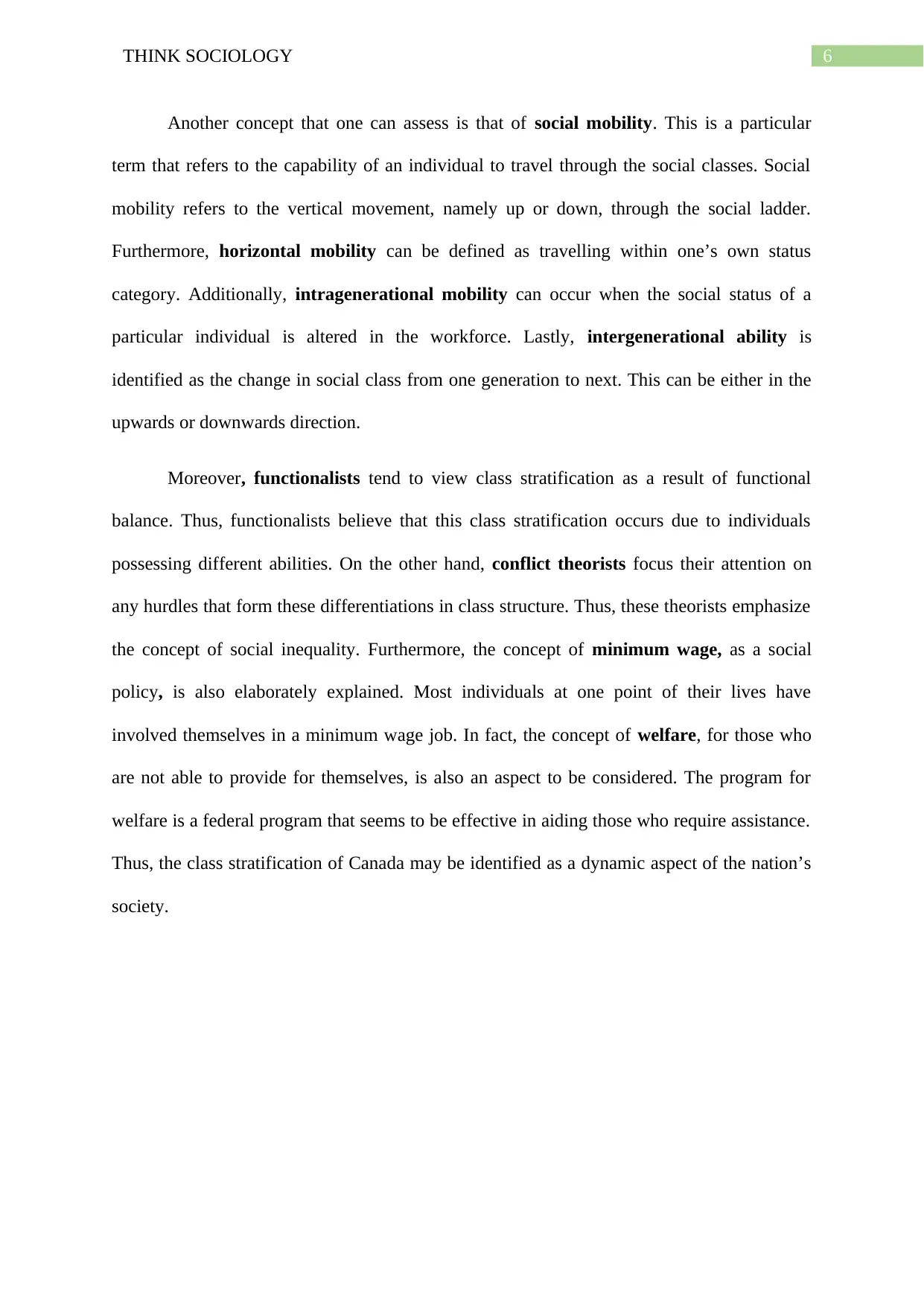
6THINK SOCIOLOGY
Another concept that one can assess is that of social mobility. This is a particular
term that refers to the capability of an individual to travel through the social classes. Social
mobility refers to the vertical movement, namely up or down, through the social ladder.
Furthermore, horizontal mobility can be defined as travelling within one’s own status
category. Additionally, intragenerational mobility can occur when the social status of a
particular individual is altered in the workforce. Lastly, intergenerational ability is
identified as the change in social class from one generation to next. This can be either in the
upwards or downwards direction.
Moreover, functionalists tend to view class stratification as a result of functional
balance. Thus, functionalists believe that this class stratification occurs due to individuals
possessing different abilities. On the other hand, conflict theorists focus their attention on
any hurdles that form these differentiations in class structure. Thus, these theorists emphasize
the concept of social inequality. Furthermore, the concept of minimum wage, as a social
policy, is also elaborately explained. Most individuals at one point of their lives have
involved themselves in a minimum wage job. In fact, the concept of welfare, for those who
are not able to provide for themselves, is also an aspect to be considered. The program for
welfare is a federal program that seems to be effective in aiding those who require assistance.
Thus, the class stratification of Canada may be identified as a dynamic aspect of the nation’s
society.
Another concept that one can assess is that of social mobility. This is a particular
term that refers to the capability of an individual to travel through the social classes. Social
mobility refers to the vertical movement, namely up or down, through the social ladder.
Furthermore, horizontal mobility can be defined as travelling within one’s own status
category. Additionally, intragenerational mobility can occur when the social status of a
particular individual is altered in the workforce. Lastly, intergenerational ability is
identified as the change in social class from one generation to next. This can be either in the
upwards or downwards direction.
Moreover, functionalists tend to view class stratification as a result of functional
balance. Thus, functionalists believe that this class stratification occurs due to individuals
possessing different abilities. On the other hand, conflict theorists focus their attention on
any hurdles that form these differentiations in class structure. Thus, these theorists emphasize
the concept of social inequality. Furthermore, the concept of minimum wage, as a social
policy, is also elaborately explained. Most individuals at one point of their lives have
involved themselves in a minimum wage job. In fact, the concept of welfare, for those who
are not able to provide for themselves, is also an aspect to be considered. The program for
welfare is a federal program that seems to be effective in aiding those who require assistance.
Thus, the class stratification of Canada may be identified as a dynamic aspect of the nation’s
society.
Paraphrase This Document
Need a fresh take? Get an instant paraphrase of this document with our AI Paraphraser
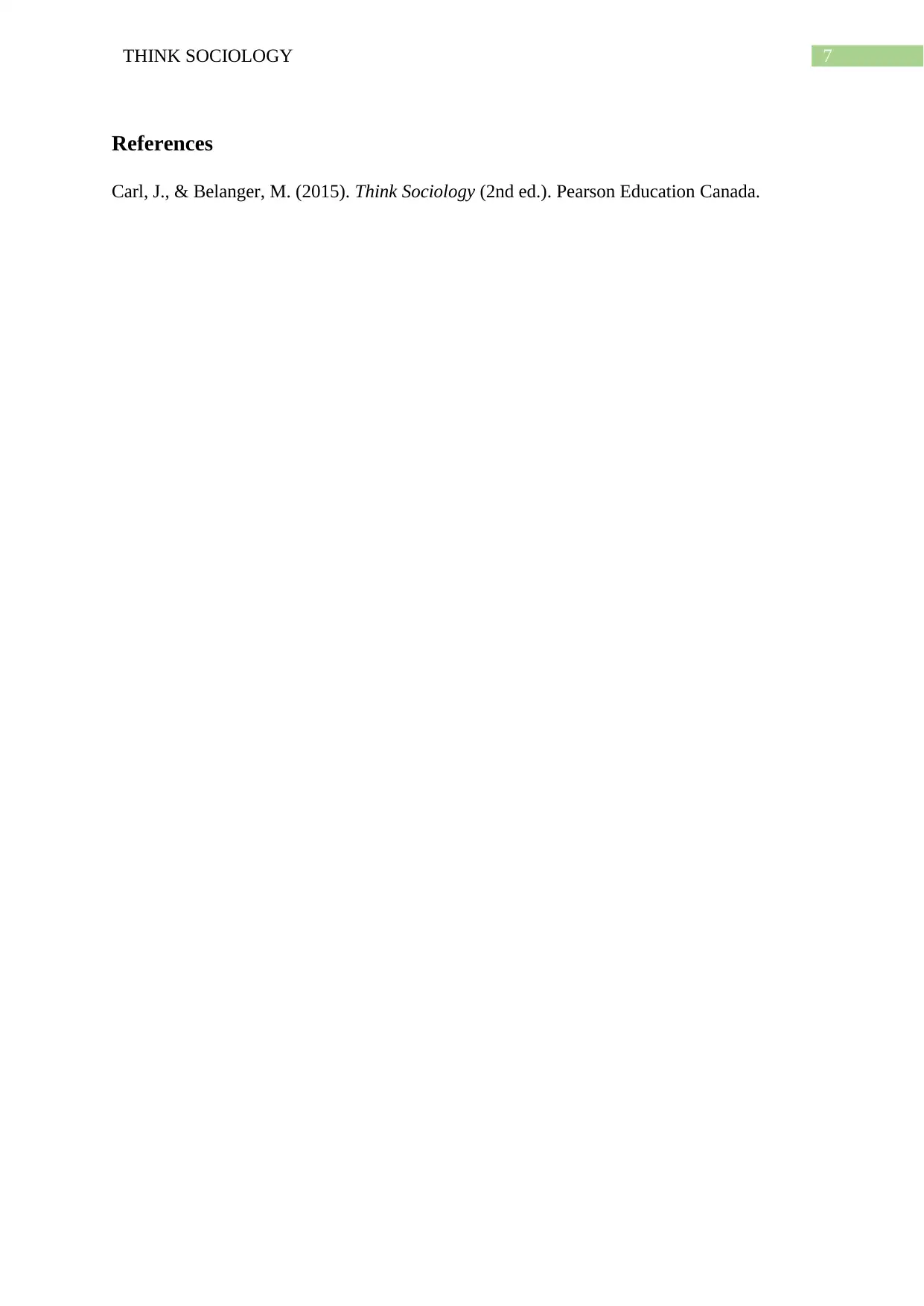
7THINK SOCIOLOGY
References
Carl, J., & Belanger, M. (2015). Think Sociology (2nd ed.). Pearson Education Canada.
References
Carl, J., & Belanger, M. (2015). Think Sociology (2nd ed.). Pearson Education Canada.
1 out of 8
Related Documents
Your All-in-One AI-Powered Toolkit for Academic Success.
+13062052269
info@desklib.com
Available 24*7 on WhatsApp / Email
![[object Object]](/_next/static/media/star-bottom.7253800d.svg)
Unlock your academic potential
© 2024 | Zucol Services PVT LTD | All rights reserved.



